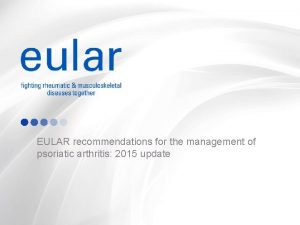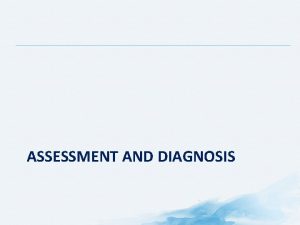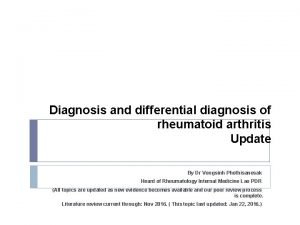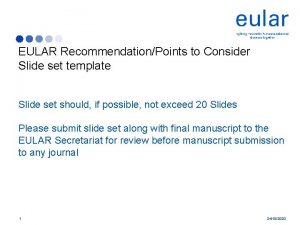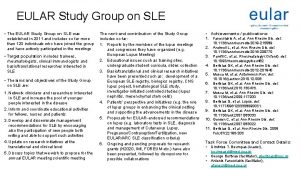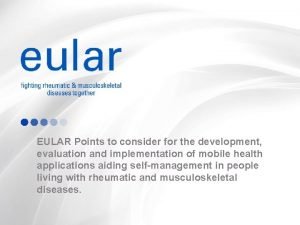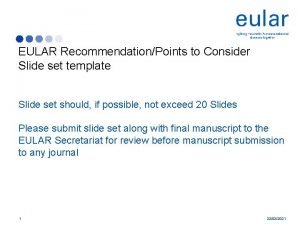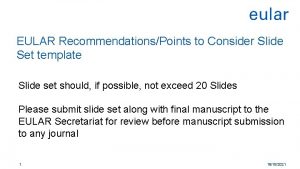EULAR points to consider for reportingscreening and preventing









- Slides: 9

EULAR points to consider for reporting/screening and preventing selected comorbidities in chronic inflammatory rheumatic diseases in daily practice : a EULAR initiative* *Baillet A, et al. Ann Rheum Dis. 2016; 75: 965 -73

EULAR points to consider for reporting/screening/preventing comorbidities Target population • Rheumatoid arthritis • Spondyloarthritis • Connective tissue disorders • Crystal arthropathies • Polyarticular osteoarthritis 2

EULAR points to consider for reporting/screening/preventing comorbidities Choice of selected comorbidities • Cardiovascular diseases related to atherosclerosis: Ø Ø Ø • Malignancies: Ø Ø Ø Ø • Serious infections Chronic viral infections Tuberculosis Non-tuberculosis opportunistic infections Gastro-intestinal diseases: Ø Ø 3 Lymphoma Skin cancer Lung cancer Colon cancer Breast cancer Prostate cancer Cervical cancer Infections: Ø Ø • Myocardial infarction Angina Stroke Transient ischeamic attack Heart failure Lower limb peripheral arterial disease Gastroduodenal ulcers Diverticulis • Osteoporosis • Depression 06/12/2020

EULAR points to consider for reporting/screening/preventing comorbidities Overarching principles Mean (SD) level of Agreement* A. Comorbidities such as cardiovascular diseases, malignancies, infections, osteoporosis, peptic ulcer and depression should be carefully assessed and managed in patients with chronic inflammatory rheumatic diseases 9. 8 (0. 5) B. All clinicians including health professionals such as nurses, treating general practitioners and rheumatologists and patients through self-administered questionnaires and selfmanagement programmes play a key role in the screening and detection of comorbidities 9. 5 (0. 9) C. Comorbidities should be subject to a systematic, standardised periodical review (e. g. at least every 5 years) for those with a chronic inflammatory rheumatic disease 9. 4 (0. 8) *Agreement of the participants on a 0 -10 scale where 0 = I fully disagree and 10 = I fully agree

EULAR points to consider for reporting/screening/preventing comorbidities Points to consider (1/3) Points to consider level of evidence * Mean (SD) level of Agreement ** 1. History of myocardial infarction, pectoris angina, stent, stroke, transient ischaemic attack, heart failure and lower limb peripheral arterial disease should be documented 5 9. 7 (0. 5) 2. Cardiovascular risk factors such as smoking status, body mass index, history of hypertension, hypercholesterolaemia, renal insufficiency and HEART-SCORE index should be documented 1 b 9. 5 (0. 9) 3. Current cardiovascular treatments such as antihypertensive therapy, antiplatelet therapy, diabetes insulin or non-insulin therapies, lipid-lowering agents and anticoagulants should be documented. 5 9. 6 (0. 7) 4. History of malignancies should be documented 5 9. 6 (0. 8) 5. Screening procedures for malignancy (including mammography, pap smear, visit to a dermatologist, feacal occult blood test, colonoscopy) and for malignancy risk factors (including history of breat or colon cancer and personal history of inflammatory bowel disease) should be documented. 1 b 8. 9 (1. 4) Cardiovascular diseases Malignancies * Level of evidence (Oxford) from 1 = very high to 5 = experts’opinion **Agreement of the participants on a 0 -10 scale where 0 = I fully disagree and 10 = I fully agree

EULAR points to consider for reporting/screening/preventing comorbidities Points to consider (2/3) Points to consider level of evidence Mean (SD) level of agreement Infections 6. History of tuberculosis should be documented including prior results of chest X-ray, tuberculin skin test, interferon- release assay and BCG vaccination 2 a 9. 8 (0. 5) 7. History of serious infections, opportunistic infections and chronic viral infections should be documented 5 9. 6 (0. 5) 8. Vaccination status for infections including influenza, Streptococcus pneumoniae, herpes zoster, human papillomavirus, poliomyelitis, diphtheria, tetanus and hepatitis B should be documented. 1 b 9. 5 (0. 7) 9. History of gastroscopy-proven peptic ulcer should be documented. 5 9. 1 (0. 9) 10. Risk factors for peptic ulcer such as age>65 years, proton pump inhibitor intake, personal history of complicated ulcer, Helicobacter pylori infection, current use of aspirin, nonsteroidal anti-inflammatory drugs, corticosteroids and anticoagulants should be documented. 5 9. 1 (0. 9) Peptic ulcer * Level of evidence (Oxford) from 1 = very high to 5 = experts’opinion **Agreement of the participants on a 0 -10 scale where 0 = I fully disagree and 10 = I fully agree

EULAR points to consider for reporting/screening/preventing comorbidities Points to consider (3/3) Points to consider level of evidence* Mean (SD) level of Agreement** 11. History of osteoporotic fracture should be documented. 5 9. 5 (0. 7) 12. Risk factors for osteoporosis including body mass index <19, physical inactivity, glucocorticoid exposure, alcohol intake, family history of femoral neck fracture, secondary osteoporosis, bone mineral density should be collected and the FRAX global risk should be calculated where applicable. 2 b 9. 0 (1. 2) 13. Current or prior osteoporosis treatments including calcium/vitamin D supplementation, biphosphonates, strontium ranelate, raloxifene, teriparatide and denosumab should be documented. 5 9. 5 (0. 7) 14. History of depression, current depression and prior screening for depression should be documented. 5 9. 0 (1. 2) 15. Current treatments for depression should be collected. 5 9. 2 (0. 9) Osteoporosis Depression * Level of evidence (Oxford) from 1 = very high to 5 = experts’opinion **Agreement of the participants on a 0 -10 scale where 0 = I fully disagree and 10 = I fully agree

EULAR points to consider for reporting/screening/preventing comorbidities Summary (Scientific format) • The consensus process led to 3 overarching principles and 15 points to consider related to the six comorbidities with tree sections: 1. Reporting (e. g. occurrence of the comorbidity and current treatments) 2. Screening for disease (e. g. mammography) or for risk factors (e. g. smoking) 3. Prevention (e. g. vaccination) • The six comorbidities were the following: Ø Ø Ø Cardiovascular diseases related to atherosclerosis Malignancies Infections Gastro-intestinal diseases Osteoporosis Depression

EULAR points to consider for reporting/screening/preventing comorbidities Summary (Lay format) • Patients with chronic inflammatory rheumatic conditions might suffer from other medical conditions (e. g. hypertension, …) called comorbidities • Comorbidities in patients with chronic inflammatory rheumatic diseases are frequently neglected • This EULAR initiative focused on the following comorbidities: Ø Cardiovascular disease Ø Malignancies Ø Infections Ø Gastro-intestinal diseases Ø Osteoporosis Ø Depression • This EULAR initiative aimed to improve Ø The reporting (e. g. occurrence of the comorbidity and current treatments) Ø The screening for disease (e. g. mammography to detect a breast cancer) or for a risk factor (e. g. smoking for cardiovascular disease and lung cancer) Ø The prevention (e. g. vaccinations to prevent infection diseases.
